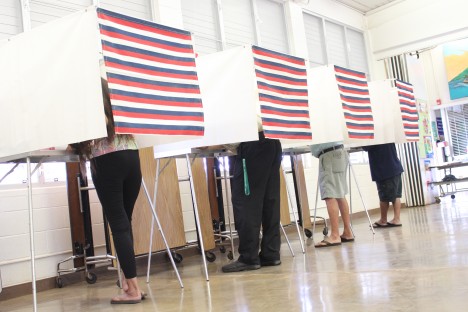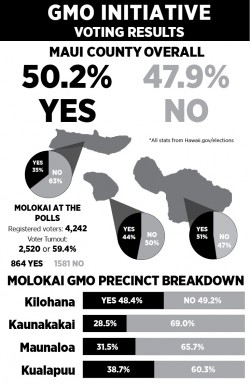Incumbents Take Stage in General Election

Voters filled out ballots at Kaunakakai Elementary, one of five polling stations on the island. Photo by Colleen Uechi.
Voters put down their signs and picked up their pens last Tuesday, as months of campaigning came to a head on Election Day. In this year’s General Election, Hawaii voters ushered in a new governor, while county and congressional incumbents ruled the day and results on hotly debated issues flip-flopped in a matter of hours.
“When anything happens [in the future], I can grumble, ‘cause I voted,” joked Molokai High security guard Maurice Lindsey at the Kaunakakai precinct polls, referencing the No Vote, No Grumble campaign that encouraged residents to learn about and vote on issues.
Lindsey was among 1,155 Molokai residents who cast their ballots on Nov. 4 at one of the island’s five polling stations, in addition to 664 early walk-in voters and 701 absentee mail-in ballots.* Molokai has 4,242 registered voters, including Kalaupapa, though the settlement is its own county and does not vote on Maui County issues.
Maui County Results
Election results brought no changes to Maui County officials. Mayor Alan Arakawa held on to his office, garnering 58 percent of the votes to challenger Tamara Paltin’s 42 percent. According to the State of Hawaii Office of Elections, Maui County mayors can serve a maximum of two consecutive terms, but since Arakawa did not serve his first two terms consecutively, he will return for a third in January 2015.
Voters also reelected all nine Maui County Council incumbents, including Molokai representative Stacy Helm Crivello, who ran unopposed.
Changes, however, did come to Maui County’s agricultural future. The controversial GMO initiative, which many Molokai voters named the biggest issue on the ballot, passed by a mere two percent, with 50 percent of Maui County voters saying yes to the moratorium on genetically engineered crops and 48 percent voting no. On Molokai, the overall consensus was ‘no’ by 28 percent.
“The GMO issue, that was the biggest one I wanted to vote on,” said Molokai Ranch employee Charles Pua`a-Spencer. “Agriculture is huge on this island so I think we have one of the biggest voices in this particular issue.”
After the first printout, ‘no’ votes lead 60 percent to 40 percent ‘yes’ votes. As officials continued to tally votes throughout the evening, ‘yes’ slowly took over. The switch incidentally mirrored the closest county council race, between Councilmember Elle Cochran (West Maui), the only incumbent council member to voice support for the GMO initiative, and candidate Ka`ala Buenconsejo, who opposed the initiative. Cochran trailed Buenconsejo after the first printout but ended up winning by eight percent.
Statewide Races
In the governor’s race, Democrat David Ige and running mate Shan Tsutsui secured victory over Republicans Duke Aiona and Elwin Ahu, winning by a 12 percent margin. Ige ousted current governor Neil Abercrombie in August’s primary elections to represent the Democratic Party, which was the first time an incumbent Hawaii governor had lost in the primaries.
On Molokai, four precincts voted mainly for Ige/Tsutsui, while one primarily favored Aiona/Ahu.
Tuesday’s congressional contests featured less drama than the primary elections, when the dead heat between U.S. Senate hopefuls Colleen Hanabusa and Brian Schatz came down to one Big Island precinct where voting had been postponed due to Hurricane Ana. This time, Schatz, a Democrat, won the senate race by a comfortable 42 percent margin. In the U.S. Representative race, incumbent Democrat Tulsi Gabbard overwhelmed opponents by 60 percent, while fellow Democrat Mark Takai squeaked by Charles Djou by less than three percent.
Four of the five Molokai precincts voted heavily for Schatz, while the majority votes in all of the precincts went to Gabbard.
While many states across the U.S. put a now-Republican majority into Congress, Hawaii remained largely Democratic with its representation.
Higher Turnout for Hawaii
More voters cast their ballots for the general election than in this year’s primaries. Hawaii as a whole saw a 10 percent increase in voter turnout, while Maui County turnout increased by 20 percent.
Molokai resident Emma Y. Velasco said she and many other voters are looking forward to seeing what changes the state’s newly elected officials will bring.
“I have a sense that many are ready for a change, ready for individuals that are leaning towards the light, [that] are hopeful,” Velasco said. “And that’s what I too want. Optimism.”
According to the Office of Elections, Hawaii’s U.S. senators and representatives will begin their new terms in January 2015, as will Mayor Arakawa and all Maui County councilmembers. Ige and Tsutsui will officially step into office in December of this year, while Hawaii’s state senators and representatives started their service on Election Day.
*All totals in this article calculated from statistics on Hawaii.gov/elections. Full election results can also be found at this site.












Don't have a Molokai Dispatch ID?
Sign up is easy. Sign up now
You must login to post a comment.
Lost Password